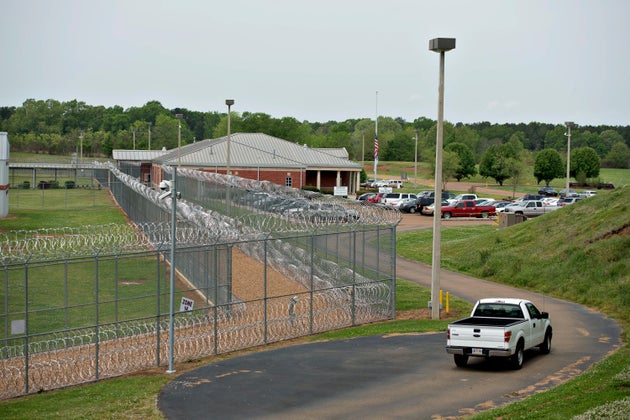“If they do not send us our inmates back, we can’t make it,” said one county supervisor.
Fencing surrounds the Walnut Grove Correctional Facility in Walnut Grove, Mississippi, U.S., on Wednesday, April 17, 2013. In Mississippis four privately run prisons last year, the assault rate averaged three times as high as in state-run lockups. None was more violent than the Walnut Grove Youth Correctional Facility. Photographer: Daniel Acker/Bloomberg via Getty Images
County officials across Mississippi are warning of job losses and deep deficits as local jails are being deprived of the state inmates needed to keep them afloat. The culprit, say local officials, is state government and private prisons, which are looking to boost their own revenue as sentencing and drug-policy reforms are sending fewer bodies into the correctional system.
In the late 1990s, as the overcrowded Mississippi prison system buckled under the weight of mass incarceration, the state asked local governments to build local correctional institutions to house state prisoners. It was billed as a win-win: The Mississippi Department of Correction would foot the bill for each prisoner, and the counties would get good jobs guarding them. The state guaranteed that the local jails would never be less than 80 percent occupied, and the locals would get a 3 percent boost in compensation each year.
After a few years, say local officials, the state offered a new deal: Instead of the 3 percent bump, they would give the locals more and more prisoners, thus boosting total revenue. Today, the state pays $29.74 per day per prisoner to the regional facilities, a deal that worked for everybody as long as the buildings were stuffed full with bodies.
Scott Strickland, president of the Stone County Board of Supervisors, said reforms at the state and local levels have shrunk the prison population. “Federal laws took some part in that — allowing prisoners to serve only a certain percentage of their term,” he said. “Also, they’ve reduced prison sentences for certain drug-related offenses.”
As the wave of mass incarceration begins to recede, the Mississippi controversy has local and state officials talking openly about how harmful locking up fewer people up will be for the economy, confirming the suspicions of those who have argued that mass incarceration is not merely a strategy directed at crime prevention. “Under the administrations of Reagan and Clinton, incarceration, a social tool used for punishment, also became a major job creator,” Antonio Moore, a producer of the documentary “Crack in the System,” wrote recently.
“I don’t think it necessarily started out this way, but the inmate population has become the backbone of some of these counties that are involved,” said Mississippi Corrections Commissioner Marshall Fisher as the controversy heated up.
The prisoners have value beyond the per diem, county officials add, when they can be put to work. State prisoners do garbage pickup, lawn maintenance and other manual labor that taxpayers would otherwise have to pay for. Convict labor has made it easier for local governments to absorb never-ending cuts in state funding, as tea party legislators and governors slash budgets in the name of conservative government.
The state knows it, and now demands that local jails house state convicts who perform labor for free, George County Supervisor Henry Cochran told The Huffington Post. The counties take the deal. “You’re either gonna go up on everybody’s garbage bill, or you’ve gotta house those inmates,” Cochran said. “You’re using that inmate labor, so [taxpayers are] getting a little good out of that inmate for their tax dollars. You either gotta hire a bunch of employees or keep that inmate. It’s like making a deal with the devil.”
State lawmakers can claim to be acting conservatively, Cochran said, but they’re not responsible for the consequences of their decisions. “The state’s dumping responsibility on local government,” he said.
Fisher said in February the state Corrections Department would begin repossessing prisoners from local institutions in order to “reduce spending by $5 million to comply with Gov. Phil Bryant’s recent order.”
In a statement at the time, Fisher said that he was re-evaluating the agency’s spending, given “low pay, high turnover, critical staff shortages, and aging facilities.”
The state was paying prison guards so little that it couldn’t even find staff for its community work centers, which run the convict labor program, Fisher said. Mississippi, in other words, couldn’t even afford free labor. “I don’t like having to close community work centers, but we simply don’t have the staff to keep some of them operating. Until we improve the pay of corrections officers, staffing will continue to be a critical issue,” Fisher said.
Like Mississippi, neighboring Louisiana, as well as Kansas, have recently become laboratories for conservative policy, with hard-line Republicans slashing taxes and dramatically cutting spending. The argument was that the tax cuts would fuel growth. Instead, the states have become economic basket-cases — Kansas actually performed worse economically than its neighbors. Deficits in Kansas and Louisiana both soared and basic services have been cut beyond the bone.
The next to fall in Mississippi will be workers at regional jails that have lost 20 percent of their inmates. Officials in Stone County and George County said that around 40 employees in each would be laid off if the jails were forced to close, a necessity if the inmate population or the state reimbursement doesn’t increase. The counties are losing $72,000 per month each, officials said. Both counties still owe significant sums on bonds that financed the jails, so even if they shut them down to stop the bleeding, taxpayers will still be on the hook.
“It’s a game,” said Scott Strickland. “The commissioner of corrections wants raises for all his state employees, so he’s trying to cry wolf.”
Strickland noted that it costs the state roughly $43 per day to lock people in Mississippi facilities, and that none of the inmates in Stone County were looking forward to being moved. “They treat them rough up there,” he said of the state prisons.
Jeffrey Schwartz, a consultant who has advised jails and prisons, said Mississippi’s battle is a strange turn of events. “It is a state that has had lots of problems within corrections. This is quite a new twist,” he said. “In the great overcrowding days, there were battles between the counties and the state over whether the state had to take inmates from the counties, and the states said we’re not taking any more, and the sheriffs said, well you have to.” A sheriff, Schwartz recalled, once dropped inmates off at a state prison, handcuffed them to the fence, and drove off.
But local officials are investigating whether the state inmates are instead winding up in private prisons. “According to their reports, they have some private prisons that they are actually paying up to $80 a day. I think it’s political favors going around, the reason they’re doing that, but that’s neither here nor there,” Strickland said.
Mississippi contracts with a Utah company called Management and Training Corp. to house some of its prisoners. Stone County Supervisor Dale Bond questioned why the state would send inmates to the private prison at more than double the cost of transferring them to a county facility. “Some of these private prisons have got 1,000 inmates and they’re getting that large per diem,” he lamented. Management and Training Corp. wasn’t immediately able to comment.
“By the end of May, we’ll be well over a quarter-million in the red on that facility,” said Bond of Stone County’s facility. “If they do not send us our inmates back, we can’t make it.”
Bond said the county supervisors have asked for permission to bring prisoners from out of state to cover the shortfall, but he worried red tape will slow the flow of human traffic. “I don’t know how reliable that is. By the time we get that approved, we’re gonna be broke,” he said.
At a recent meeting with state officials, Bond said, the state Corrections Department offered to pay off one sheriff’s bond and close the county facility, but he turned down the offer. “No, we don’t want that, we want the jobs,” the sheriff said.
For Strickland, something has to give. “In a way, we were sort of devastated. That revenue needs to be made up,” he said.


